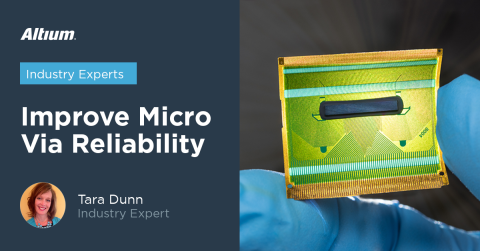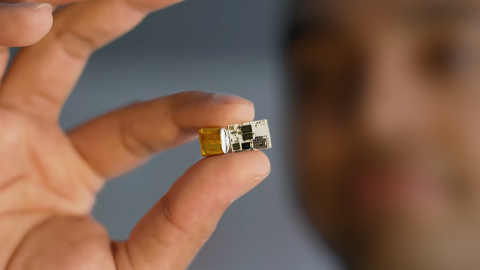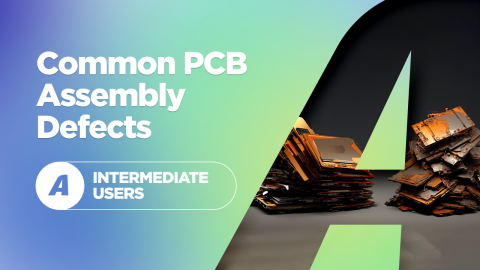Direct Metallization Process for PCB Via Fabrication

When vias and plated through-holes are fabricated in a PCB, they require a metal deposition and plating process in order to build up the required copper on the hole wall. Building up the metal film on a via wall is performed with a process known as electroplating, but before this process is performed a primary metallization process is needed to form a seed layer for further deposition. There are primary metallization processes that can be used to support the subsequent electroplated copper process: electroless copper and direct metallization.
Electroless copper is the standard long-standing primary metallization process that is used throughout the industry. In low density designs, electroless copper is a thoroughly used process and does not present significant reliability problems as long as it is properly controlled. In high-density PCBs, reliability problems with electroless copper plating may become more apparent due to the small feature sizes in microvias.
As more devices continue to miniaturize, we expect capacity for direct metallization to increase, and this will address the need for reliable fabrication and plating capacity for UHDI designs. This coincides with expected growth in IC substrate demand and follows the current trend of onshoring of electronics manufacturing capacity.
Primary Metallization Overview
Primary metallization processes in PCB manufacturing are performed after drilling and desmear, and the process is used to form a seed layer inside a drilled hole that requires plating. The seed layer forms along the hole wall, as illustrated below, and this seed layer forms the base for subsequent electroplating.
Primary metallization and via formation with electroplating.
After deposition of the copper layer with electroplating up to the final hole wall thickness (1 mil in most designs), outer layer plating and solder mask are applied, which can then apply the final plating layer to any vias that will be untented. Once the via walls are plated, microstructure analysis might be performed to assess the deposited copper thickness in the hole wall and ensure plating uniformity along the hole axis.
At large diameters, including with large aspect ratios, the resulting plating is generally of very high quality and is known to be highly reliable. As we scale to smaller sizes, electroless copper begins to exhibit some reliability challenges that motivate the use of tighter process controls, or a complete shift to the direct metallization process.
Electroless Copper
Electroless copper is the traditional primary metallization process used prior to electroplating. The process deposits a thin layer of copper from solution with a palladium catalyst directly on the PCB dielectric material. Once the thin copper layer is deposited, the electroplated copper is deposited on top until the final copper plating thickness is reached. The process involves a reduction reaction of copper ions using formaldehyde in the presence of a palladium catalyst.
2HCHO + 2OH− → 3H2 (g) + 2CO2 + 2e-
Cu2+ + 2e- → Cu (metal).
The deposition of one copper film onto another copper film brings the potential for several reliability challenges in the electroplated copper on the hole wall. During electroplating, the deposited copper can have different fill factor, grain structure, and uniformity compared to the electroless copper. This creates a lower mechanical strength compared to a complete film of copper with uniform grain structure. The interface between the two copper films can be seen in the example SEM image below.
Source: Cobley, Andrew J., Bahaa Abbas, and Azad Hussain. "Improved electroless copper coverage at low catalyst concentrations and reduced plating temperatures enabled by low frequency ultrasound." International Journal of Electrochemical Science 9, no. 12 (2014): 7795-7804.
As the process involves a reaction involving an acid, hydrogen gas will form as one of the reaction products. As this is a dynamic liquid bath process, the hydrogen gas needs to escape from the plating region in order to ensure the electroless copper layer is uniform. This is less of a problem at larger hole diameters, but plating in smaller hole diameters can experience trapped hydrogen gas which may compromise the electroless copper layer.
Direct Metallization
The process eliminates three of the major sources of reliability problems in the via hole wall plating. These are:
- Elimination of hydrogen as a reaction product
- Elimination of the electroless-electroplated copper film interface
- Stabilization of the plating bath which allows for downtime without replenishment
By eliminating the hydrogen gas product and the copper-copper film interface, films formed by direct metallization tend to have higher uniformity and higher mechanical strength. In addition, because this process also involves a chemical bath, it can be used with larger plated through-holes; it is not exclusive to microvia formation.
Currently, much of the direct metallization capacity is with large multinational manufacturers, which means that technology is primarily found in Asia or with advanced prototyping companies. As more capacity is expected to come online, this will broaden the range of locations where companies can produce.
Do Your PCB Design Rules Need to Change?
The answer here is a solid “no,” the PCB design rules for via design do not change if direct metallization is to be used for via formation. This applies in HDI PCB design where microvias are being used, and in traditional through-hole designs where hole diameters are larger. However, if direct metallization is the desired manufacturing process, consider contacting your fabrication house to inquire about their processing capabilities. You can also specify the use of direct metallization as a preferred process in your PCB fabrication notes.
Whether you need to build reliable power electronics or advanced digital systems, use the complete set of PCB design features and world-class CAD tools in Altium Designer®. To implement collaboration in today’s cross-disciplinary environment, innovative companies are using the Altium 365™ platform to easily share design data and put projects into manufacturing.
We have only scratched the surface of what’s possible with Altium Designer on Altium 365. Start your free trial of Altium Designer + Altium 365 today.










